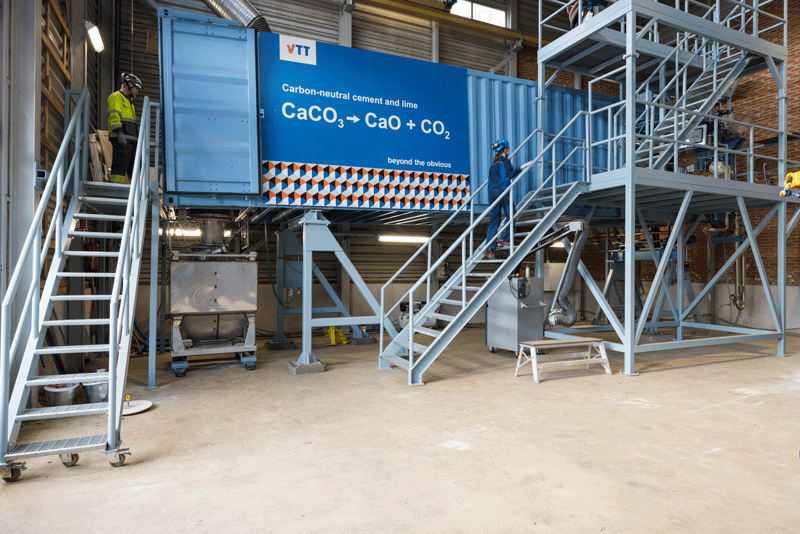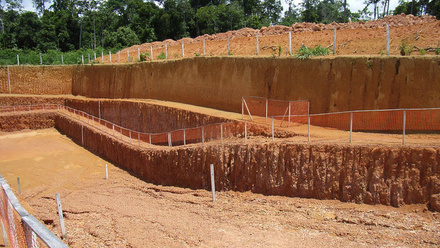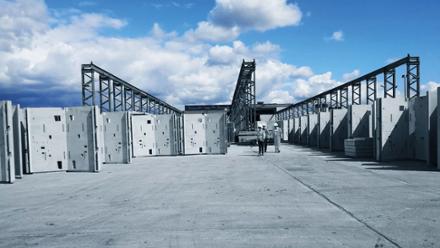Cutting carbon emissions in cement and quicklime production
A Finnish consortium with ambitions to replace combustion processes with electricity-based solutions claims it can significantly reduce carbon emissions in cement and quicklime production.

The gas-tight, electrically heated rotary kiln used to achieve the preliminary results also has the potential to reduce emissions in other industrial sectors, say the partners behind the Decarbonate project.
Project lead, VTT Technical Research Centre of Finland, worked with manufacturer Kumera to build a 12m, gas-tight, electrically heated rotary kiln, which has been tested at VTT with the consortium’s 11 business partners, including cement manufacturer Finnsementti and limestone supplier Nordkalk. The kiln is stored in a sea container so it can be moved to industrial sites in the future.
VTT’s research suggests that, in theory, it is possible to run a cement plant with close to zero CO2 emissions by substituting combustion with low-emission electricity for decomposing calcium carbonate (limestone), the main raw material used for cement production.
The carbonate contained in the limestone is a problem because it decomposes into CO2 and quicklime when heated. The only way to avoid the emissions is to replace the limestone. Besides the construction sector, quicklime is also used in huge quantities in, for example, steel industries.
The aim was to replace existing fuel use of rotary kilns with electricity. In addition, the team says this makes it easier to capture the resulting high concentration of CO2, because it is not diluted to flue gases anymore, for storage or manufacture of low-emission products.
Initially, VTT used a 2m vertical tube reactor in its laboratory to test the production of both quicklime and the lime mud used in pulp mills.
Project manager and principal scientist Eemeli Tsupari explains, ‘The results were promising, so we started to search for interested partner companies to supply a pilot kiln. Finnish manufacturer Kumera was selected and built a bigger kiln than was originally envisaged, which was better at exposing the limitations of scaling up, such as heat transfer. Kumera has solved several challenges in kiln design.’
Commissioned in late 2021, VTT, together with its business partners, carried out some preliminary tests of the precalcination of lime using the kiln in an industrial setting at VTT’s site. Cement raw powder and pulp mill lime mud will be tested in early 2022.
However, Tsupari says further studies need to be undertaken to assess the technology’s feasibility for industrial applications and the resultant materials properties. The Decarbonate project is looking for funding options so it can take the electric kiln concept to the next level.
‘Scaling up is one of our research questions,’ he says. ‘In addition to savings in fuel and CO2 costs, one of the benefits for kiln operators could be new revenues for power grid services.
‘The main benefit is probably the possibility to label their products as ‘carbon neutral’, or ‘low carbon’. However, it’s important that if the CO2 is utilised, for example, as synthetic fuels, both (lime producer and fuel producer) cannot claim their product as carbon neutral. Emissions certainly decrease, but only once.’
The consortium notes that EU emissions trading is steering industries towards reducing emissions. At the current price level, a decrease of one tonne in CO2 emissions is the equivalent of €70 for a business. ‘For a medium-sized cement plant, for example, a one-third reduction in emissions would mean savings of several million euros per year,’ it says.
Tsupari points out that the test kiln could be used for reducing emissions in other industrial sectors, such as the battery and asphalt industries. ‘[Finnish mining company] Keliber is one of the partners in our consortium and they are investigating if this type of kiln could be used in their process to produce lithium. In stationary asphalt stations, fuel usage can be decreased by electric pre-heating and heating as well.’




